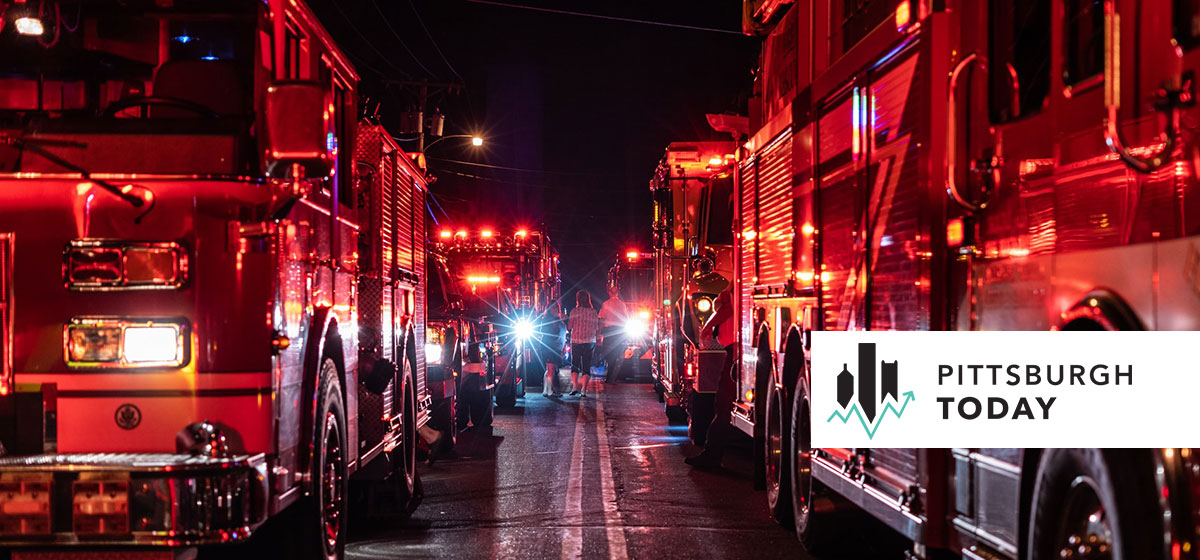An Eroding Anomaly

The economic fallout of the pandemic threatens to weaken long-struggling fire and ambulance services in southwestern Pennsylvania that were already strapped for cash.
Although the way the region’s fire and ambulance services are structured varies, they share daunting challenges including a dearth of new staff and a perennial lack of funding.
And social distancing restrictions imposed to slow the spread of the coronavirus have put fire department festivals, social hall rental and other key sources of income at risk, lending strength to the argument that a better way of sustaining critical emergency response services is needed.
“This concern has been brewing for a few decades,” said Michael Carpenter, a local government policy specialist with the Pennsylvania Department of Community & Economic Development. “It cries out for greater attention, greater creativity, innovation and flexibility.”
A region of volunteers
Volunteers comprise 90 percent of the overall population of active firefighters in the seven-county Pittsburgh Metropolitan Statistical Area, according to 2020 data from the U.S. National Fire Administration. That’s the highest percentage of all 16 Pittsburgh Today benchmark regions. The Philadelphia MSA comes in second highest at 80 percent volunteers. Baltimore is a distant third at 65 percent. Boston has the lowest percentage of volunteers at only 3 percent.
Pennsylvania’s tradition of volunteer-based public safety predates the founding of the United States. Benjamin Franklin established the all-volunteer Union Fire Company in Philadelphia in 1736, the first organization of its kind in the 13 colonies.
“I wouldn’t want to diminish the work of these volunteers over the years,” said Richard Schuettler, executive director of the Pennsylvania Municipal League. “It’s amazing that [the system has] worked as well as it has.”
But recruiting the volunteers critical to those operations is difficult today. The tipping point came in the late 1970s. The number of volunteer firefighters in the Commonwealth has declined from 300,000 in the 1976 to about to 38,000 in 2018, according to data from the Pennsylvania Fire and Emergency Services Institute.
The lack of new volunteer firefighters reflects a wider decline in volunteerism and civic engagement across the nation. A 2018 study from the University of Maryland found that volunteering and charitable giving declined among every age group from 2002 to 2015 nationwide. Experts suggest the trend is fueled by a number of socioeconomic factors, including an increasing number of working parents, the flattening of wages and residents being more likely to work outside of their home communities.
For volunteer fire departments, the trend makes the job of volunteers more difficult and stressful.
“Taken together, the many tasks performed by a decreasing number of volunteers only exacerbates the problem and overwhelms those who remain active,” according to a 2018 report on Pennsylvania’s emergency services commissioned by the state General Assembly. “It is the consensus of the Commission that a public safety crisis is unfolding due to the continuing decline in the ranks of our emergency service volunteers.”
Fundraising to survive
Many municipalities in the Pittsburgh MSA provide some degree of financial support to their volunteer fire departments. But it’s up to the fighters themselves to raise most of the money they need to balance their annual budgets.
Christopher O’Leath, a volunteer for the City of Arnold fire company station #2 in Westmoreland County, said their department’s major expenses include trainings, maintenance on vehicles and equipment, and loan payments on the firehouse and social hall owned by the company. In a typical year, their operating budget is around $100,000.
Before the pandemic, renting the social hall was the Arnold VFW’s main source of revenue, which was supplemented with public fundraising drives during the spring and summer. This year, the department is already $90,000 behind its fundraising goals after being forced to cancel several public events in the last three months, O’Leath said.
“What you’re seeing now is a significant financial impact that a lot of these departments are facing,” said Steve Bicehouse, director of Emergency Services for Butler County. “The traditional carnival, or gun bash or any fundraiser they may have had, they can’t have it now.”
In contrast to the largely volunteer fire departments, ambulance services in the Commonwealth are almost exclusively private businesses, but not terribly profitable ones.
“The financial situation of the state’s EMS agencies is a key reason for the ongoing declining number of agencies,” reads the general assembly report. “Continually rising costs for EMS personnel, benefits, vehicles, equipment, fuel, insurance, utilities and facilities coupled with lack of adequate payment for services is eliminating agencies statewide.”
For ambulance services, the majority of revenue comes from reimbursements from Medicare and Medicaid for treating and transporting patients enrolled in those government health insurance programs. While the costs of training and equipment have significantly increased over the last several decades, reimbursements paid from these providers have declined.
The 2018 statewide report noted that “Medicare and Medicaid programs pay fee-for-service below the cost of providing that service.” Medicare reimbursement rates, for example, are, on average, 6 percent less the cost per transport, according to a study by the U.S. Government Accountability Office, which provides Congress with information. The study also found that, in some states, Medicaid only covers one-quarter of the cost.
As a result, salaries for emergency technicians in many areas “are equal to or below those offered in the fast food and retail industries,” reads the statewide report. The number of emergency medical technicians in Pennsylvania has declined by over 6,000 since 2012. In the same period of time, the number of paramedics declined by 4,000.
Now, with the pandemic curtailing both the emergency calls and the routine transport that make up the life-blood of private ambulance companies, many local crews are struggling to survive.
In addition to his volunteer firefighting, O’Leath also works as the director of operations at Freeport Emergency Medical Service, an ambulance company based in Armstrong County. The organization had access to the paycheck protection program and a reserve fund that, he said, should allow it to survive the year.
But, he said, “some smaller services, they’re not going to come out on the other end of this pandemic.”
Exploring reforms
Giving the state greater influence over local fire departments and EMS service is among the key recommendations made in the 2018 state General Assembly report for helping ease the crisis they are facing.
“Despite worsening trends, the delivery of fire and EMS services continues to be a local responsibility. This has created a significant decline in service and citizen protection across the Commonwealth to the point where the most basic emergency assistance in some areas is no longer assured,” the report states. “Much like education, social welfare, and police protection, fire protection and EMS must, to some degree, become a Commonwealth responsibility.”
The report suggests the state take greater control over hiring and setting service requirements for first responders. It lays out a vision of a system that consolidates local fire and ambulance services across regions. “The concept would be to provide a core of career personnel to handle the ‘routine’ responses supported by volunteers to handle more involved responses.”
Increasing public support for first responders might be hard to come by in a post-corona world of shrinking and stressed municipal budgets.
“If everybody has to have paid fire, you’re going to seeing significant local tax increases,” Schuettler said. “There’s no way to pay for that without substantial financial resources.”
But, he said, Harrisburg and many smaller governments will at some point have to rethink their relationship to their local emergency response crews as the pandemic cleaves away their traditional supports.
“Everything is going to be looked at. If the service can’t be provided, and you have citizens at risk, then you have no choice.”





